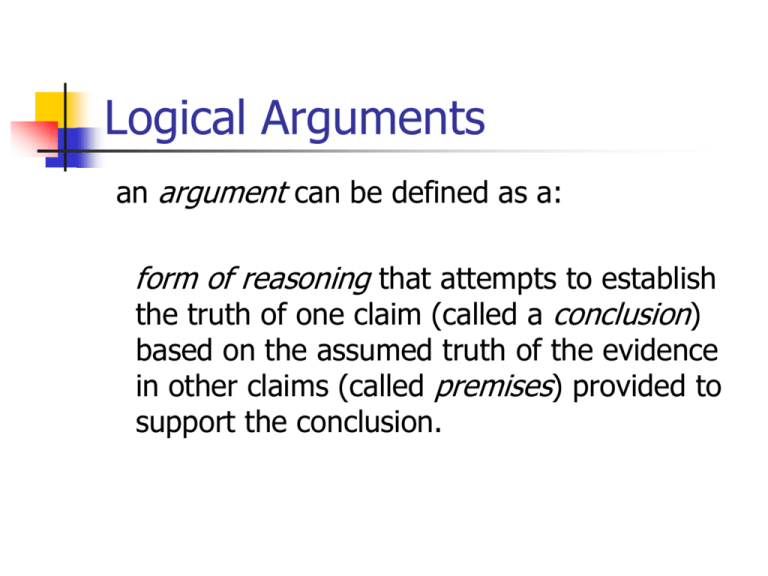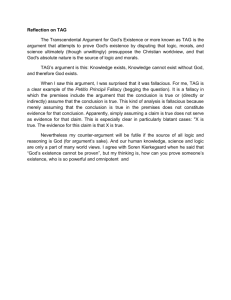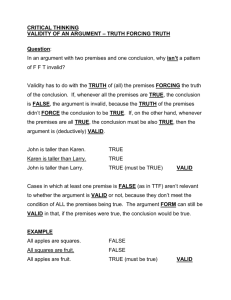argument
advertisement

Logical Arguments an argument can be defined as a: form of reasoning that attempts to establish the truth of one claim (called a conclusion) based on the assumed truth of the evidence in other claims (called premises) provided to support the conclusion. Arguments continued An argument has three important characteristics or features in that it: (i) Is a "form of reasoning." (ii) Is comprised of claims (sometimes also called statements or assertions). (iii) Aims at establishing a conclusion (i.e., one claim) based on evidence provided (by other claims) Structure of an Argument Premise 1 . optional . optional Premise N optional Conclusion Argument structure continued Premise 1. When I recently visited the Computer Science Department at the University of Hiroshima I noticed that graduate students and professors there were field testing a new computer chip, whose code name is Chip X. Premise 2. I have a copy of the design specifications for Chip X, which shows that it will be several times faster than any chip currently available in the US. Premise 3. Lee Smith, a mutual colleague of ours who was recently an exchange student in the computer science program at the University of Hiroshima and who participated in the field testing of Chip X, will corroborate my account. ________________________________________ Conclusion. Chip X is currently being developed in Japan. Sample Arguments continued Premise 1. An author's freedom to write a book on how to build a bomb is one that is protected by the First Amendment. Premise 2. Authoring a book is similar to constructing a Web Site. ___________________________________________ Conclusion. Constructing a Web site on how to build a bomb ought to be protected by the First Amendment. Sample Arguments continued Premise: The Internet is in public space. ________________________________ Conclusion: Therefore, those who use the Internet should not expect to retain any personal privacy. Critical Thinking Skills for Identifying Logical Fallacies in Everyday Reasoning The term "fallacy" does not mean false statement. It means faulty reasoning. So it is possible for an argument to contain all true statements and still be fallacious. Informal Logical Fallacies Many fallacies appear in everyday reasoning. Logicians have categorized them in ways that are convenient for us to recognize. We refer to these kinds of fallacious arguments as informal logical fallacies. Some Common Informal Fallacies Ad Hominem Argument Slippery Slope Argument Fallacy of Appeal to Authority False Cause Fallacy Begging the Question Fallacy of Composition/Fallacy of Division Fallacy of Ambiguity Appeal to the People (Argumentum ad Populum) The Many/Any Fallacy The Virtuality Fallacy Constructing an Argument in Ordinary Language (Prose) We must build a national missile defense system (NMD) because without such a system we are vulnerable to nuclear attacks from rogue nations that might arise in the future. Additionally, several engineers and computer scientists have testified that they can design a computer-guided missile defense system that is effective, safe and reliable. Furthermore, it is our obligation as Americans to take whatever measures we can to protect the safety of our citizens. NMD First Ethical controversies to catch the attention of a group of computer ethics pioneers (p75). Converting to Standard Form Premise 1. Without the new National Missile Defense System, the US is vulnerable to nuclear attacks in the future from "rogue nations. Premise 2. Computer scientists and engineers have testified that they can design a computer-guided missile defense system that is both safe and reliable. Premise 3. The US must do whatever is necessary to preserve the military defense of the nation and the safety of its citizens. ____________________________________________________ Conclusion. Therefore, the US should build the new National Missile Defense System. Is the argument valid? Now we ask, “is the reasoning used in the argument strong? Are there rules that will enable us to determine this?” We must understand the difference between valid and invalid arguments. Claims are either true or false Arguments will be either valid or invalid It is incorrect to refer to an argument as either true or false It is also incorrect to refer to a claim as invalid or valid The Counterexample Strategy To show that an argument is invalid, all we need to do is to produce one counterexample to the argument. A logically possible case in which the argument’s conclusion could be imagined to be false while (at the same time) the argument’s premises are assumed true. Counterexample We can imagine a logically possible case where the conclusions “The US should build the NMD system” is false when claims stated in Premises 1-3 are assumed true. All three could be true, but some alternative strategy not involving the NMD could provide for the safety of America. So a counterexample is possible; thus the argument is invalid. Figure 3-1 Arguments Valid The assumed truth of the premises is sufficient to guarantee the conclusion. Invalid Premises (even when true) do not guarantee the conclusion. NMD Argument Reconstructed Premise 1. Without the new National Missile Defense System, the US is vulnerable to nuclear attacks in the future from "rogue nations. Premise 2. Computer scientists and engineers have testified before Congress that they can design a computer-guided missile defense system that is both safe and reliable. Premise 3. The US must do whatever is necessary to preserve the military defense of the nation and the safety of its citizens. Premise 4. The national missile defense system is necessary to preserve the defense and safety of the US and its citizens. ____________________________________________________ Conclusion. Therefore, the US should build the new National Missile Defense System. Figure 3-2 Valid Arguments Sound Unsound All the premises are true. At least one premise is false. Figure 3-3 Invalid Arguments Inductive Conclusion likely follows from assuming the truth of the premises. Fallacious Conclusion does not likely follow from assuming the truth of the premises. Figure 3-4 Comprehensive View of Arguments Arguments Valid Unsound Weak Arguments Invalid Sound Inductive Strong Arguments Fallacious Weak Arguments Seven-step Strategy for Evaluating Arguments: I (Part 1: Steps 1-4) Step 1. Convert the argument into standard form. (List the premises first, followed by the conclusion.) Step 2. Test the argument for its reasoning strength to see whether it is valid or invalid. (Assume the premises to be true, and ask yourself whether the conclusion must also be true when those premises are assumed true. Is a counterexample to the argument possible?) Step 3. Is the argument valid? If yes, go to Step 4. If no, go to Step 5. Step 4. Is the (valid) argument also sound? That is, are the premises true in the actual world? 4a. If the argument is valid and if all of the premises are true in the actual world, then the argument is also sound. (To determine truth-values for statements, see Appendix E.) 4b. If the argument is valid, but one or more premises can be shown to be either false or not capable of being verified in the actual world, then argument is unsound. Seven-Step Strategy For Evaluating Arguments: II (Part II: See Steps 1-4 on previous slide) Step 5. Is the (invalid) argument inductive or fallacious? (How likely will the conclusion be true when the premises are assumed true?) 5a. If the conclusion would likely be true because the premises are assumed true, the argument is inductive. 5b. If the conclusion would not likely be true even when the premises are assumed true, the argument is fallacious. (Keep in mind that a fallacious argument can be made up of Individual claims that are themselves true in the actual world.) Step 6. Determine whether the premises in your argument are either true or false. Step 7: Make an overall assessment of the argument. That is, describe the argument's strength of reasoning in conjunction with the truth conditions of the argument's premises. For example, is the argument inductive with all true premises? Is it inductive with some false premises? Is it fallacious with a mixture of true and false premises, and so forth? Remember that an inductive argument with premises that are all true is stronger than a valid argument with one or more false premises.)








